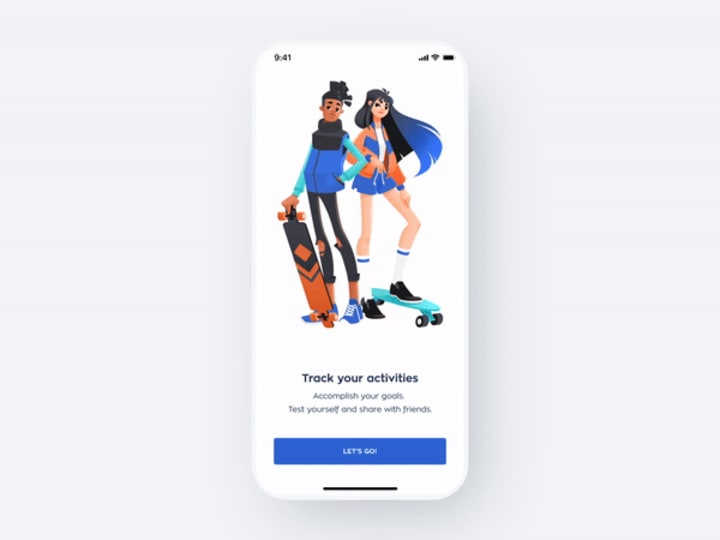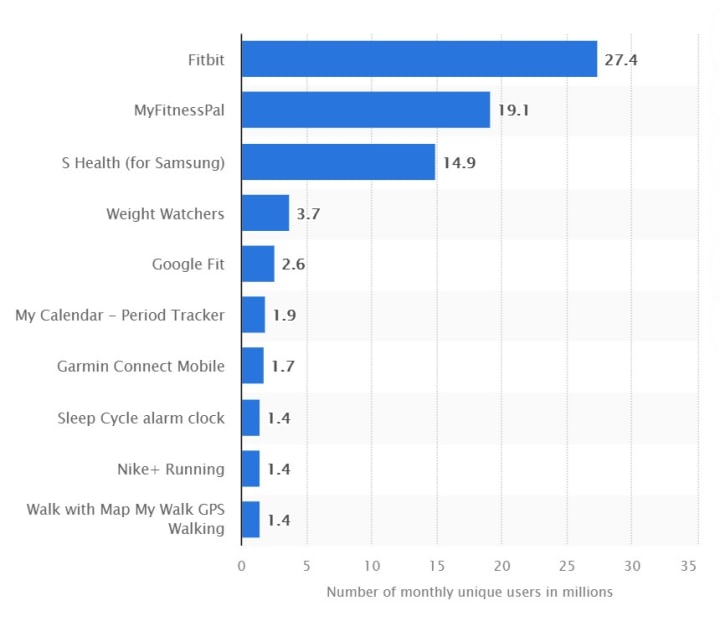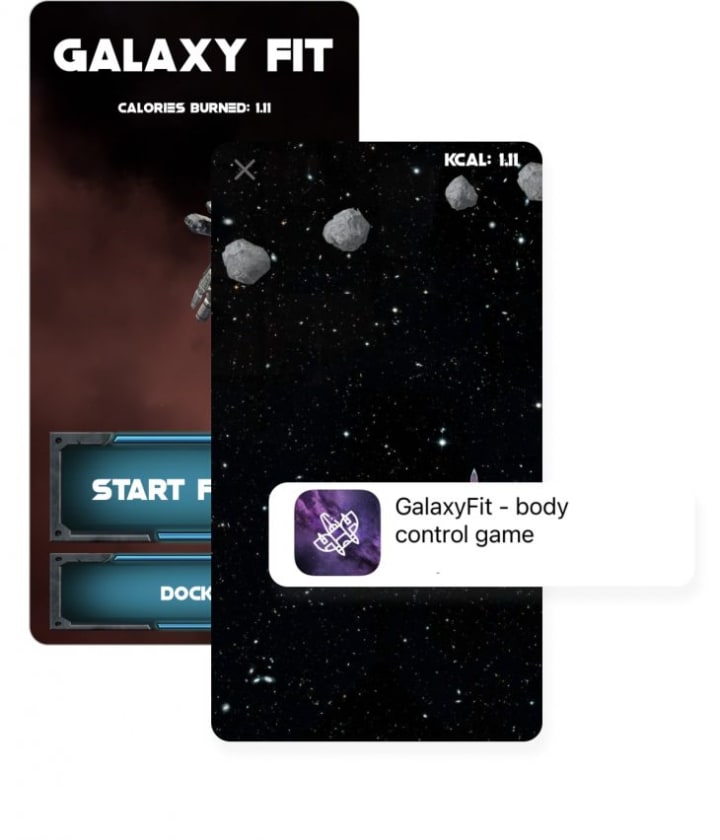Fitness App Gamification In 2021: A Trend You Cannot Miss
App gamification is such a cool thing, as it makes fitness applications funnier and even addictive. They are more popular, less likely to be removed, and can attract more users and make them stay and buy a premium subscription to play again. We will help you find out whether the idea of creating a gamified fitness app is relevant in 2021, and if it is worth the investment it requires. Get into the topic deeper with us, do a little research, observe existing apps, and get inspired to create a new one.

What a person who buys a fitness app wants
The app that turns exercise into fun will always win among others. Don’t forget that 73% of people who set fitness resolutions end up quitting before hitting their targets. The only aim that a user has when they browse for a fitness app in the App Store or Google Play is the desire for a beautiful, athletic body. This is the ultimate goal. So, if you can get people over their laziness with the right approach in your app – it will succeed.
It’s almost an unbelievable thing for a person to stick to their sports routine without giving up on it on day three. What helps a person to keep being fit is an easy and playful presentation of exercises that instantly engages them and, most importantly, does not give them a chance to give up.

What your target user really wants is to become beautiful and attractive and sexy in a short amount of time. This is possible only with strict adherence to the training schedule and nutrition plan. If we leave the nutrition plan to another application that calculates calories, and an AI that develops personalized diets for each user, what’s left is a joyful and professional approach to a training program.
Fitness app creation in 2021
In 2020, more than 71,000 health and fitness apps were released globally, so it is challenging to get to the top of the huge list. And moreover, fitness apps have registered an increase in the number of daily active users and downloads all over the world since 2020. India registered the largest increase at 84.0% (approximately 12 million new users). The Middle East and North Africa increased by 28%, while America registered an 8.0% increase during the quarantine period.
Looking through the statistics of app usage, we can conclude that the traffic is huge for the healthcare segment:

We can see that most leaders’ profiles are old-timers and are fairly classic in their approach. Most of them are built on the basic concepts of counting calories, illustrating exercises, and timing everything out.
But if we are talking about creating a standard application that will count calories, connect with your wearable devices, and configure functions such as Apple Health, this is a completely different story. There are too many of them already – if you go through the health and fitness category in the app list, you can find thousands. And this creates a problem of promotion for any app that is not truly fresh.
A fitness application should provide full user involvement in the process and an easy, positive emotional background so that its user will want to perform exercises regularly.
So, the gamification is an involving factor and will become one of the main trends in future years. We are not going to hold a full app gamification research, but let’s dive deeper into the topic.
Gamification increases engagement
Despite the popularity of being fit during isolation, now many are accustomed to a sports lifestyle and want to continue to keep fit. So people are constantly searching for a great app to have on hand. Most of the users are tired of classic fitness coach app ideas and looking for something that will motivate them more.
The topic of beauty, healthy lifestyle, and body fit will never dry up. But the trends are constantly changing, so the developers need to adapt. The integration of gamification components into fitness apps is one of the main trends. Do you remember PokemonGo app? This was the first ultra-popular step counting game, one of the best gamification apps in 2016, where users were required to walk a lot to win. From the day the firstborn of this trend appeared, the idea of an effective gamification app engagement in physical activity has been getting ever stronger.
52.5% of App Store fitness apps contain at least one element of gamification. But there are no fully gamified apps at the top of this leader’s list. And this is a chance for those who are creating an innovative app in 2021. The first question that a person who wants to create such an app has is about the complexity of its gamification. Why not create a classic one, like Nike Run Club for example, and try to repeat its success? The market for classic track running apps is really difficult to succeed in, as the top competitors have taken the niche so strongly, their positions seem carved in stone and just getting stronger every day.

So, it is much more difficult to persuade a user to swap an app they’ve already got used to for a new one that is almost the same, than to create something new, exclusive, entertaining, and challenging in the same niche. That is why gamification as a trend can be a key to success. Let’s get into a classification of gamification types to choose the right one for your app.
Types of gamification in fitness apps
There are so many ways to turn serious physical activity into fun with a gamified plot and UI. Or, alternatively, use engaging peer motivation as a reward for a person’s effort to make sport not a goal, but an instrument of satisfaction.
As an example, look at the Fit for Bucks app. It is an app development case of Shakuro company. Fit for Bucks build stronger communication between local business owners while promoting physical activity. It allows users to use their daily step count in exchange for the local merchants’ products.

Gamified applications use your phone and wearables to track your physical activity. PlayFit, for example, has a pedometer, squat and push-up counters. Increasing activities count opens access to the next challenges.
It’s possible to make your workouts more fun by tracking all these motions. You climb up to new activities and win rewards as you complete daily and weekly movement targets. At the same time, you become fitter and fitter. This is a deep psychological effect based on the motivation of immediate rewards. What can be more effective for a user? Let’s look at two classic types of app gamification.
Structural mobile app gamification
This type uses game components to guide a user through content, with no adjustments or alterations to the content itself. The goal of this sort of gamification is to keep the user engaged by rewarding them as they progress directly through the plot of the app.
Allowing learners to earn points for watching an instructional video is an example of this form of gamification in e-learning. And for a fitness app, it is even simpler: a user completes one exercise to unlock the next one, for example. There are some common components to this type of gamification:
Achievements. A classical component of games – something that is earned after passing tasks.

Points. Getting points for any activity, like watching a video or completing an exercise.
Rank. One of the greatest motivations to continue is to get a higher rank among other users or compared to your own past results.
Levels. As players move through the content, it continues to build on the previous concepts.
Peers. This is an external component, but very strong. Social achievement is part of gamification. Gaming makes exercise addictive, as does social attention.
Content gamification of apps
You change the content to make it more game-like in the instance of content gamification, incorporating interactive components to boost user engagement.

Finding an entertaining task, rather than starting with a classic exercise routine, is one example of content app gamification.
7 best fitness apps with game elements in the App Store
What is the main motivational concept of these free gamification apps? Let’s look through the most engaging apps of 2021.
Paying attention to fun elements, gamification components, and health behavior constructs, here are seven app gamification examples. We’ve decided to divide the list by the kind of gamification used in the applications.
Gamified AR apps – augmented reality fitness
Plaicise – if you’re focused on this game, you won’t notice your weariness, and you’ll even forget that you’re exercising. That’s why this app transforms workouts into an augmented reality game. A user is concentrated on winning inside the reality the app offers while doing serious physical exercises. A user places stands in front of their smartphone with a front camera, and the AI translates gestures into game controls on the screen. One of the greatest things about this app is that users can play online with friends and train together.

BetterMe – super-entertaining TikTok AR games inspired app is also AR gamified. BetterMe combines cutting-edge technology and dynamic scenario. Players use body movements to replace a hero character while doing full training at the same time. The user completes stages and collects stars to unlock new levels – all while losing weight and improving fitness.

Galaxy Fit – this app is built on the principle of motivating users to stand up from the office table and play for a little while having major health benefits. The simulation on a display shows the moves of the player’s body. The galactic ship moves through the universe, calories burn – that’s so easy.

Burn your fat with me – this is an anime-inspired healthcare app and at the same time a dating simulator. It uses a concept that uses “moé”, a Japanese term for the feeling you get when you see a cute female anime character, and it motivates players to keep doing exercises. The user is “seduced” into doing all the exercises along with the main character. Meanwhile, some serious physical activities are done.

Simulator fitness app with gamification
Zombies, Run – ”You tie your shoes, put on your headphones, take your first steps outside. You’ve barely covered 100 yards when you hear them. They must be close. You can hear every guttural breath, every rattling groan – they’re everywhere. Zombies. There’s only one thing you can do: Run!”
It is a fully immersive audio app that tracks running and imitates monsters following the user. Every jogging session is a mission thanks to the audio drama that has been written by professional writers and composers. This app immerses you in a zombie adventure scenario. Moreover, this is one of the best apps for running as it motivates to train even more, as the player should get “supplies” on the way to survive.

Pedometer – just like in best running apps
Wokamon – “The more you walk, the more Wokamons you can collect and the further you get to explore the magical Woka-worlds like candy desert, icy realm, mystical forest, and more!“
This is a classic adventure simulation game that makes walking exciting and motivates you with an engaging story. This is one of the best apps for running beginners because of its simplicity and highly motivational concept.

Walkr – this is one more step counter app that motivates users to walk a lot for exploring the infinite cosmos. 500,000 users tried this app already.

Gamified fitness app market depth in 2021
We wrote an article about fitness app market technology trends in 2019. And since that time, the number of users in the health and fitness category is growing steadily. Moreover, researches and studies predict it to grow twice until 2028:

People are interested in the topic, and they are searching App Store and Google Play for such apps. It would seem there is no better opportunity than creating an application that both motivates you to do exercises and is entertaining at the same time. Nevertheless, it is possible due to the abundance of applications that are classic fitness companions, gamification just gets lost in hundreds of other developing options.
Also, surprisingly, many applications of this kind have very low ratings, few downloads, and in general, the popularity of these applications does not amaze. To date, the amount of motivating, well-thought-out fitness applications with elements of gamification is low. Most likely, this is due to the fact that creating an application based on gamification requires much more investment and resources than creating a classic application with calorie counting. A classic one requires just a shell of a new design corresponding to the trend of the year in which it is created.
Isn’t it too late to start gamified fitness applications development? How the market is growing, what are its trends? Would it be possible to make money on such apps? Analyzing and predicting the market of fitness app with gamification, consider these points:
- Penetration of smartphones
- Obesity and overweight among potential users
- Download trends for fitness apps
The penetration of smartphones was 57% in 2017 and will reach 77% by 2025. The number of mobile subscriptions is also increasing. Users are in demand of healthcare solutions right on their smartphones. Especially in the wake of 2019-2020 self-isolation. Smartphones fitness solutions are irreplaceable for those, who get used to home workouts. Potential users evaluated the ease and cheapness of training with fitness apps. Some people aren’t planning to get back to reopening gyms. Gamification can only make their home workouts more engaging. It can help to stick to physical activities with more joy.
Obesity and overweight tendency is a valuable factor. Roughly one out of three U.S. adults are overweight or obese (2020). And this number can increase twice by 2030. Concern over obesity causes the adoption of various weight reduction methods. It caused a fitness app demand over the past few years. And it made the Health & Fitness category in the App Store one of the most competitive. These facts are enabling even greater use of fitness apps in the future. And what about gamified fitness app as a possible solution to the problem? It appears to be good support for users suffering from obesity. And it is a promising business opportunity, judging by fitness app market movement:

Download trends for fitness apps. The number of US fitness apps users raised from 62 to 87 million from 2018 to 2021. People can’t imagine their lives without physical activity tracking. And this addiction grows by market study data. Fitness apps and devices are the best companions for such a lifestyle. Gamification can only raise the app’s value for users and add plenty of joy to daily physical activity. These facts take a strong place in building predictions for gamified fitness app success.
So, if you are wondering how to create a fitness gamification app, take your chance and contact us so we can do it together.
About the Creator
Shakuro
We are a web and mobile design and development agency. Making websites and apps, creating brand identities, and launching startups.






Comments
There are no comments for this story
Be the first to respond and start the conversation.